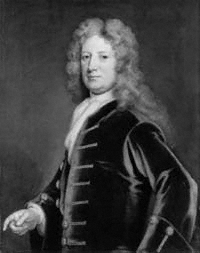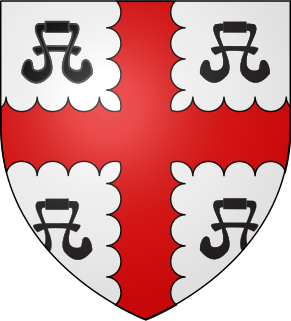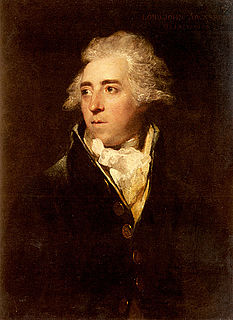
Baron de Ros of Helmsley is the premier baron in the Peerage of England, created in 1288/89 for William de Ros, with precedence to 24 December 1264. Premier baron is a designation and status awarded to the holder of the most ancient extant barony of the Peerage of England. The present premier baron is Baron de Ros. Before the Dissolution of the Monasteries the Prior of the Order of St John in England was deemed premier baron.

Earl of Leicester is a title that has been created seven times. The first title was granted during the 12th century in the Peerage of England. The current title is in the Peerage of the United Kingdom and was created in 1837.

Marquess Townshend is a title in the Peerage of Great Britain held by the Townshend family of Raynham Hall in Norfolk. The title was created in 1787 for George Townshend, 4th Viscount Townshend.

Marquess of Northampton is a title that has been created twice, firstly in the Peerage of England (1547), then secondly in the Peerage of the United Kingdom (1812). The current holder of this title is Spencer Compton, 7th Marquess of Northampton.

Earl Ferrers is a title in the Peerage of Great Britain. It was created in 1711 for Robert Shirley, 14th Baron Ferrers of Chartley. The Shirley family descends from George Shirley of Astwell Castle, Northamptonshire. In 1611 he was created a Baronet, of Staunton Harold in the County of Leicester, in the Baronetage of England. He was succeeded by his son Henry, the second Baronet, who married Lady Dorothy Devereux, daughter of Robert Devereux, 2nd Earl of Essex. On the death of her brother Robert Devereux, 3rd Earl of Essex, she became the youngest co-heir to the baronies of Ferrers of Chartley and the barony of Bourchier, which had fallen into abeyance on the death of the third Earl. Shirley was succeeded by his eldest son, the third Baronet. He died unmarried and was succeeded by his younger brother, the fourth Baronet. He was imprisoned in the Tower of London by Cromwell and died there in 1656. On his death the title passed to his eldest son, the fifth Baronet. He died at an early age and was succeeded at birth by his posthumous son, the sixth Baronet.

Baron Hastings is a title that has been created three times. The first creation was in the Peerage of England in 1290, and is extant. The second creation was in the Peerage of England in 1299, and became extinct on the death of the first holder in c. 1314. The third creation was in the Peerage of England in 1461, and has been in abeyance since 1960.

Baron Willoughby de Eresby is a title in the Peerage of England. It was created in 1313 for Robert de Willoughby. Since 1983, the title has been held by Jane Heathcote-Drummond-Willoughby, 28th Baroness Willoughby de Eresby.

Baron Wharton is a title in the Peerage of England, originally granted by letters patent to the heirs male of the 1st Baron, which was forfeited in 1729 when the last male-line heir was declared an outlaw. The Barony was erroneously revived in 1916 by writ of summons, thanks to an 1844 decision in the House of Lords based on absence of documentation. As such, the current Barony of Wharton could more accurately be listed as a new Barony, created in 1916, with the precedence of the older Barony.

Baron Hungerford is a title in the Peerage of England. It was created on 7 January 1426 for Walter Hungerford, who was summoned to parliament, had been Member of Parliament, Speaker of the House and invested as Knight of the Order of the Garter before and was made Lord High Treasurer one year before he became a peer. The man who would later succeed as third baron was created Baron de Moleyns on 13 January 1445 by writ of summons; both titles merged when he succeeded as Baron Hungerford in 1459. The third baron was attainted and the peerage forfeit in 1461. This attainder was reversed in 1485 for the then 4th baroness of Hungerford, and so it came into the Hastings family of Earls of Huntingdon until 1789, when it came into the Rawdon(-Hastings) family of the Marquesses of Hastings until 1868 when it fell into abeyance. This abeyance was terminated three years later for a member of the Abney-Hastings family and an Earl of Loudoun. In 1920 it again fell into abeyance, which was terminated one year later for the Philipps family of the Viscounts of St Davids where it has remained since.
The title Baron Bergavenny was created several times in the Peerage of England and once in the Peerage of Great Britain, all but the first being baronies created by error. Abergavenny is a market town in South East Wales with a castle established by the Norman lord Hamelin de Balun c. 1087.

John Villiers Stuart Townshend, 5th Marquess Townshend, known as Viscount Raynham from 1855 to 1863, was a British peer and Liberal Member of Parliament.
The title Baron Ferrers of Chartley was created on 6 February 1299 for John de Ferrers, son of Robert de Ferrers, 6th Earl of Derby. The daughter of the 6th Baron Ferrers of Chartley, Anne, married Walter Devereux who was summoned to parliament as Lord Ferrers in her right. Their descendants became Earls of Essex and the peerage was forfeited in 1601 on the attainder of Robert Devereux, 2nd Earl of Essex, but restored to his son Robert in 1604, on whose death in 1646 the peerage fell into abeyance. The abeyance was terminated in 1677 when Robert Shirley, a grandson of one of the sisters of the 3rd Earl of Essex, was summoned as Lord Ferrers of Chartley with precedence to the original creation. In 1711, Shirley was created the 1st Earl Ferrers, but the Earldom and Barony separated at his death, the barony going to Elizabeth Shirley, the daughter of his eldest son, while the earldom went to his second son. On the 1741 death of Elizabeth Shirley, 15th Baroness Ferrers of Chartley and wife of the Earl of Northampton, the peerage again briefly fell into an abeyance that was resolved in 1749 by the death of two of the three heiresses, leaving the surviving daughter, Charlotte Compton, wife of the Marquess Townshend, as 16th Baroness Ferrers of Chartley. The barony continued, merged with the marquessate, until the death of George Ferrars Townshend, 3rd Marquess Townshend in 1855, when it again fell into abeyance between his two sisters and their heirs. It remains in abeyance.

The title of Baron Bonville was created once in the Peerage of England. On 10 March 1449, Sir William Bonville II was summoned to Parliament. On his death in 1461, the barony was inherited by his great-granddaughter Cecily Bonville, who two months before succeeded as Baroness Harington, with which title the barony merged until 1554, when both baronies were forfeited. From her death in 1529 to the forfeiture in 1554, the baronies were merged with the title of Marquess of Dorset.

The title Baron Bourchier is an abeyant peerage which was created in the Peerage of England in 1342 for Sir Robert Bourchier, who had been Lord High Chancellor of England from 1340–41.

George Townshend, 2nd Marquess Townshend, PC, FRS, known as The Lord Ferrers of Chartley from 1770 to 1784 and as The Earl of Leicester from 1784 to 1807, was a British peer and politician.

George Ferrars Townshend, 3rd Marquess Townshend, known by the courtesy titles of Lord Ferrers of Chartley and Earl of Leicester, was a British peer. His homosexuality caused a scandal and resulted in the rapid breakdown of his marriage and disinheritance by his father. He moved abroad and died at Genoa, then in the Kingdom of Sardinia, without issue.
James Compton, 5th Earl of Northampton, known as Lord Compton from 1687 to 1727, was a British peer and politician.
Charlotte Townshend, Viscountess Townshend, suo jure16th Baroness Ferrers of Chartley and 7th Baroness Compton, known as Lady Charlotte Compton until 1749 and as Lady Ferrers of Chartley from 1749 to 1764, was a British peeress.
Elizabeth Compton, Countess of Northampton, suo jure15th Baroness Ferrers of Chartley, was a British peer.

Lord John Townshend PC, styled The Honourable John Townshend until 1787, was a British Whig politician.











